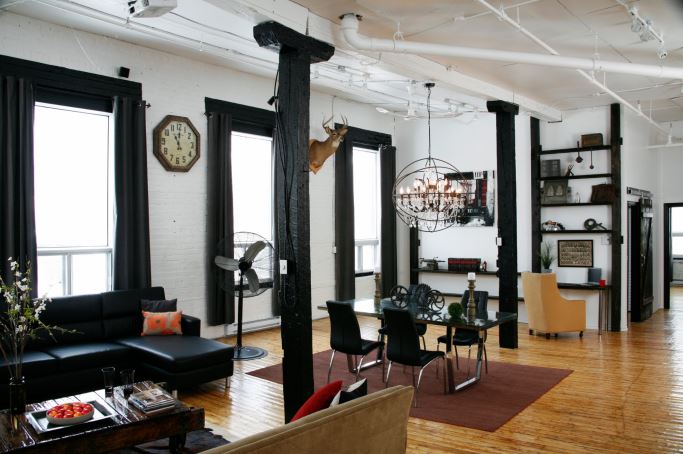Apartment in industrial building has quirky edge
BY PHILLIPA RISPIN
PHOTOGRAPHY: JEAN BLAIS
STYLING: DENISE PALISAITIS
Accessories: Revive Decor
How’d you like to spend your vacation in a factory that makes industrial steam irons? Not enthused? You might be after you learn about this quirky apartment in the Old Port.
It’s managed by business partners Jeff Letendre, Marco Gomez and Yann Denault. They have a thriving vacation-rentals business, but their properties are mostly in the Plateau. Jeff, however, realized that this location was a winner.
“I found this place and it was pretty bad, just a big old factory,” he recounts. “But I really liked the location and the views you get of downtown. I just knew we would end up doing something really cool with it. People tend to like industrial chic places nowadays. I saw the value in it right away.”
The building was erected in 1880 and had always been occupied by industry. In 1959, it was bought by William Blank who owned Wm. Blank Mfg. Co., a company that has been in the building ever since. Currently owned by a partnership that includes William’s son, Howard, it shows more than 100 years of wear and tear in its three storeys. But it’s also contributed to Montreal’s social history, too.
Artist Moe Reinblatt, who became Canada’s official war artist in 1944, shared studio space with Eudice Garmaise on the second floor. Outsized media personality and disco king Douglas “Coco” Leopold lived on the third floor for about 17 years.
“He was a great guy – active in the social scene, that’s for sure,” Howard says. “What’s interesting is that before Jeff came in, (actress) Pia El Metni lived there for a while, and her father knew Douglas. It had sentimental value to live in the place. Up until three or four years ago Coco’s connection was still quite active.”
In a way it still is, according to Jeff. “I meet people and they tell me, ‘Oh, we used to have massive after-hours parties in there.”
The parties have been superseded by vacationers and visitors to the city who encounter an apartment rather different from Coco’s loft. It’s got a bit of an edge, but with comfort and style. However, Jeff and partners’ original vision was difficult for others to see.
“I really like going into a great location, a great building,” Jeff says. “I like when it’s rough and nobody can identify with it, and everybody says ‘Are you guys crazy? You’ll never do anything with this place.’
“Now it’s unique. The place is not perfect, and I like it that way. For instance, the floors are so uneven you wouldn’t believe it, but it doesn’t matter because we shift the furniture to the good spots. It has character.”
Jeff, Yann and Marco took over the place in 2013. Renovations began in October, and heavy overtime was needed to prepare it for Christmas rentals. The 2,000-square-foot open space is now an apartment with two bedrooms, an open-plan kitchen/dining/living room, and an enormous bathroom. The wavy floors have been sanded and polished, and the apartment is now the industrial-chic space that Jeff wanted.
There were glitches along the way, of course. The heat of last July showed that individual air-conditioning units are just not adequate in the voluminous space, and now there’s a central thermopump that handles air conditioning and heating. In the depths of winter, additional heat is provided when necessary by baseboard heaters.
The thermopump is a thoroughly contemporary device, as are some of the furnishings, but there’s still plenty of the past in evidence.
Jeff found historic items in the building. “It was like a flea market of great old stuff. I walked around with Howard and asked ‘Can I showcase this? Can I exhibit that?’ They’re not stuff that was crafted to look old; they’re the real thing.”
One of those real things is a photo collage of the 1929 graduating class of École technique de Montréal, with Howard’s father, William, striking a classic pose. Some of the old furniture is the real thing, too, originally used in the Château Frontenac, in Quebec City.
“They refurbished the whole place recently,” Jeff explains. “I found the guy who bought the whole lot, and I bought a few sofas from him. They have history to them.”
Jeff isn’t a professional designer, but he has a strong sense of what he wants and what looks right in a space. “It’s something we’ve developed over time,” he says. “I’ve done so many projects. I wouldn’t call myself a designer. It’s just something I do for fun. Well, it’s for business, but I like doing it. It’s my business now.”
Jeff’s design sense is illustrated by how he explains the choice of chandelier over the dining table: “I think the most expensive item was the chandelier. To me it was important to have something luxurious in the middle of the room. It gives so much to the rest of the space. It has presence.
“It’s exactly what I was trying to achieve. You have those industrial-looking, rough rings around the outside. And then you have the chandelier itself, more luxurious. The two go together pretty well. And this is what the place is all about.”







